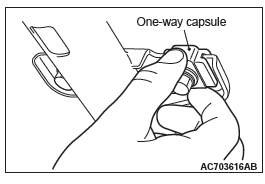Mitsubishi Outlander: On-vehicle Service
STEERING WHEEL FREE PLAY CHECK
1. With the engine running (hydraulic pressure applied), position the front wheel in the straight ahead direction.
2. Measure the side to side steering wheel play until the front wheels actually start moving while turning the steering wheel slightly in the left and right directions.
Limit: 30 mm (1.2 inch) or less
3. If the steering wheel play exceeds the limit value, check the steering shaft joint or steering linkage for looseness, and replace or repair the faulty components if necessary.
4. If the steering wheel play still exceeds the limit value after Step 3 is performed, position the steering wheel in the straight ahead position, and then apply the force (approximately 5 N) in the circumferential direction.
At this time, check if the steering wheel play is within the standard value.
Standard value : 16.5 mm (0.65 inch) or less
5. If the steering wheel play is outside the standard value after Step 4 is performed, remove the steering gear and linkage, and check and adjust the pinion total rotation torque.
STEERING ANGLE CHECK
CAUTION After adjusting the steering angle, always perform calibration to make ABS/ASC-ECU learn the neutral position of the steering wheel sensor. (Refer to GROUP 35C − On-vehicle Service − Steering Wheel Sensor Calibration). <Vehicles with ASC>
1. Check that the wheel alignment is normal.
2. Place the front wheel onto the turning radius gauge, and measure the steering angle.
Standard value:

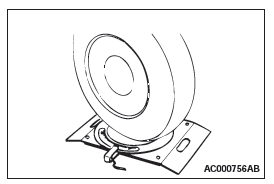
3. If not within the standard value, adjust the tie-rods (right and left), and repeat Steps 1 and 2.
4. If the measured value exceeds the standard range by performing Step 3, replace the steering gear and linkage assembly.
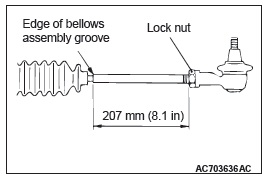
TIE-ROD LOOSENESS CHECK
When an abnormal noise is generated by the steering system, check the tie-rod for looseness. For the tie-rod looseness check, using a push-pull gauge and a spring scale, carry out the items below.
- Install a dial gauge.
- Check the points to load for a push-pull gauge and a spring scale.
- Operate to stabilize the load and fluctuation with a push-pull gauge and a spring scale.
- Carry out the dial gauge measurement and calculation with a push-pull gauge and a spring scale.
When the push-pull gauge is used
1. Before the looseness check, check the items below.
- Check that the Mitsubishi genuine wheel with specified size is mounted. Also check that the wheel bearing is not loose.
- Raise the vehicle at the jack up point on the side sill of the inspection side, and lift the tyre for approximately 30 mm (1.2 in). At this time, check that the tyre of the opposite side is grounded.
2. Install a dial-gauge respectively to the "Position a (front side position)" and "Position b (rear side position)" on the wheel rim, 25 mm (1.0 in) below from the wheel centre. (Install the dial gauges to the smooth position that is around the edge of the tyre.)
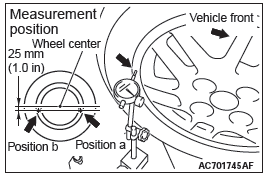
3. The push-pull gauge shall be set to the smooth position that is 25 mm (1.0 in) above from the wheel centre and the edge of the tyre on the wheel rim. Then the position on the vehicle front side shall be the "Position A" and the vehicle rear side shall be the "Position B".
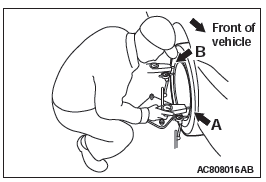
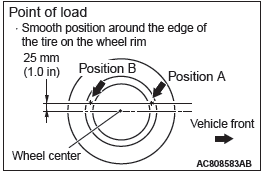
4. To stabilize the relationship between the load and fluctuation, push with the specified load by wheel size in the order of "Position A, "Position B", and "Position A" using the push-pull gauge. Note that the pushed load on each position shall be extracted.

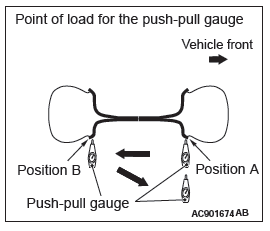
5. Using the push-pull gauge, carry out the procedure below to read the value on the dial gauge and calculate the looseness.
NOTE: The +/− sign acquired with the calculation result shall be used as it is.
- While pushing the "Position B" with the specified load by wheel size, read the values on the dial gauges at the " Position a" and "Position b". The values of the dial gauges at this time shall respectively be "aB" and "bB".

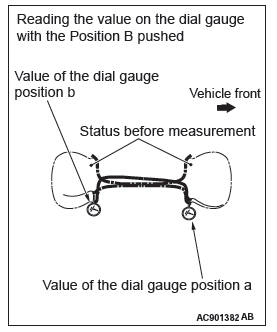
- Remove the load in the "Position B". Then while pushing the "Position A" with the specified load by wheel size, read the values on the dial gauge in the "Position a" and "Position b". The values on the dial gauges at this time shall respectively be "aA" and "bA".

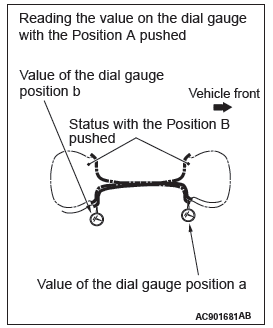
- Make calculation taking the value differences of the dial
gauge positions a and b which were read while pushing
the "Position A" and "Position B" as each fluctuation.
- Fluctuation of the dial gauge position a: aA − aB
- Fluctuation of the dial gauge position b: bA − bB
- Calculate each fluctuation difference of the dial gauge
positions a and b acquired above for looseness. Perform
the procedure above twice.
Fluctuation of the dial gauge position a − Fluctuation of the dial gauge position b
- Calculate the average of the looseness calculated twice.
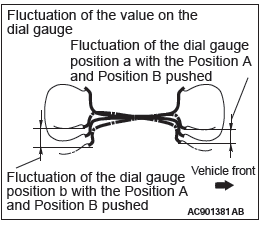
- If the average exceeds the standard value, check the tie rod
end ball joint rotation torque.
Standard value: Within +- 2.0 mm (0.08 in)
NOTE: Measure the tie-rod looseness on the right side and left side respectively.
When a spring scale is used
1. Carry out the confirmation before the looseness check with the same manner as the check using a push-pull gauge.
2. At the position that is 25 mm (1.0 in) above from the wheel centre, bind the tyre and the wheel rim with a cord for both the front and rear sides, and fix them with a tape not to loose vertically.
3. Set the spring scale to the cord bound as above. At this time, the point to pull shall be in the dimension between the "Position C" and "Position D" by wheel size, and the position on the vehicle front side shall be the "Position C" and the vehicle rear side shall be the "Position D".

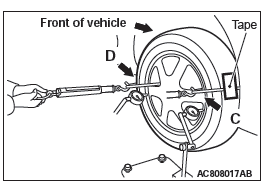
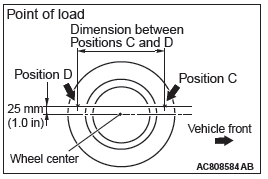
4. To stabilize the relationship between the load and fluctuation, pull with the specified load by wheel size in the order of "Position C", "Position D", and "Position C" using the spring scale. Note that the pulled load on each position shall be extracted.

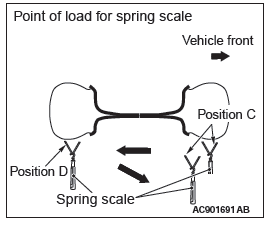
5. Using the spring scale, carry out the procedure below to read the value on the dial gauge and calculate the looseness.
NOTE: The +/− sign acquired with the calculation result shall be used as it is.
- While pulling the "Position D" with the specified load by wheel size, read the values on the dial gauges in the "Position a" and "Position b". The values on the dial gauges at this time shall respectively be "aD" and "bD".

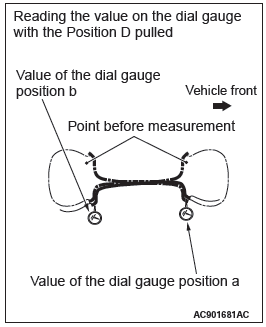
- Remove the load at the "Position D". Then while pulling the "Position C" with the specified load by wheel size, read the values on the dial gauge in the "Position a" and "Position b". The values on the dial gauges at this time shall respectively be "aC" and "bC".

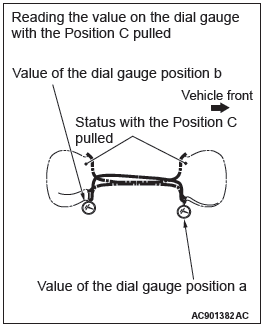
- Make calculation taking the value differences of the dial
gauge positions a and b which were read while pulling
the "Position C" and "Position D" as each fluctuation.
- Fluctuation of the dial gauge position a: aC − aD
- Fluctuation of the dial gauge position b: bC − bD
- Calculate each fluctuation difference of the dial gauge
positions a and b acquired above for looseness. Perform
the procedure above twice.
Fluctuation of the dial gauge position a − Fluctuation of the dial gauge position b
- Calculate the average of the looseness calculated twice.
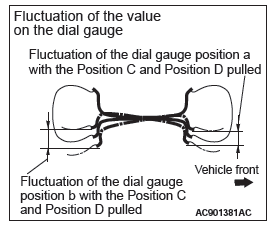
6. If the average exceeds the standard value, check the tie rod end ball joint rotation torque.
Standard value: Within +- 2.0 mm (0.08 in)
NOTE: Measure the tie-rod looseness on the right side and left side respectively.
BALL JOINT DUST COVER CHECK
1. Using your fingers, press the dust cover to check for cracks or damage.
2. If there are any cracks in the dust cover or it is damaged, replace the tie-rod end.
NOTE: If the dust cover has a crack or damage, the ball joint could be damaged.
TIE ROD END BALL JOINT ROTATION TORQUE CHECK
Required Special Tools:
- MB990326: Preload Socket
- MB991897 or MB992011: Ball Joint Remover
CAUTION
- Do not remove the nut from ball joint. Loosen it and use the special tool ball joint removal MB991897 or MB992011 to avoid possible damage to the ball joint threads.
- Hang the special tool ball joint removal MB991897 or MB992011 with cord to prevent it from falling.
1. Install the special tool ball joint removal MB991897 or MB992011 as shown in the figure.
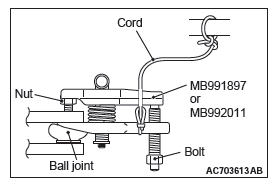
2. Turn the bolt and knob as necessary to make the jaws of the special tool ball joint removal MB991897 or MB992011 parallel, tighten the bolt by hand and confirm that the jaws are still parallel.
NOTE: When adjusting the jaws in parallel, make sure the knob is in the position shown in the figure.
3. Tighten the bolt with a wrench to disconnect the tie rod end.
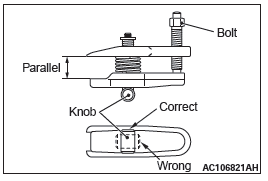
4. Move the ball joint stud several times and install the nut on the stud. Using the special tool ball joint removal MB990326, measure the ball joint breakaway torque.
Standard value: 2.9 N*m (26 in-lb) or less
5. If the rotation torque exceeds the standard value, replace the tie rod end.
6. If the rotation torque is under the standard value, check the ball joint for end play or ratcheting. If no end play or ratcheting, the ball joint can be re-used.
7. Install the tie rod end to the knuckle, then tighten a new self-locking nut to the specified torque.
Tightening torque: 25 +- 5 N*m (18 +- 3 ft-lb)
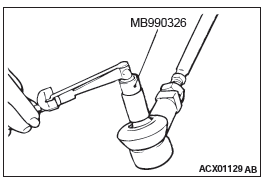
STATIONARY STEERING EFFORT CHECK
1. Park the vehicle on a level paved road, position the steering wheel in the straight ahead direction.
2. Start the engine, and maintain the engine speed at 650 +- 100 r/min <2.4L>, 600 +- 100 r/min <3.0L>.
3. Position the spring scale on the circumference of the steering wheel, and measure the steering force at the time when the steering wheel is turned to right or left side (within the range of one and a half turns) from the center position.
At the same time, verify that the steering force does not vary excessively in both directions.
Standard value:

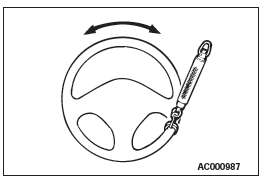
STEERING WHEEL RETURN TO CENTER CHECK
Conduct a road test:
1. Make both gradual and sudden turns and check the steering wheel return.
2. At a vehicle speed of approximately 22 mph (35 km/h), turn the steering wheel 90 degrees, hold a few seconds, then release. If the steering wheel then returns 70 degrees or more, the return can be judged satisfactory.
NOTE: There will be a momentary feeling or "heaviness" when the wheel is turned quickly, but this is not abnormal.
(Oil pump discharge amount is especially apt to be insufficient during idling.)
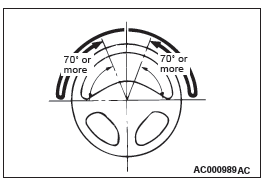
DRIVE BELT TENSION CHECK
Refer to GROUP 11A − On-vehicle service − Drive belt tension check <2.4L>, Refer to GROUP 11C − On-vehicle service − Generator drive belt tension check <3.0L>.
FLUID LEVEL CHECK
1. Park the vehicle on a flat, level surface.
2. Start the engine, and then turn the steering wheel several times to raise the temperature of the fluid to approximately 50 − 60ºC (122 − 140ºF).
3. With the engine running, turn the wheel all the way to the left and right several times.
4. Check the fluid in the oil reservoir for foaming or milkiness.
Check the difference of the fluid level when the engine is stopped, and while it is running. If the change of the fluid level is 5 mm (0.2 inch) or more, air bleeding should be done.
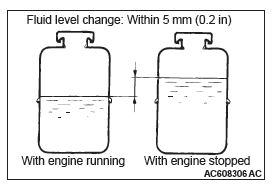
FLUID REPLACEMENT
<2.4L ENGINE>
1. Raise and support the front wheels.
2. Disconnect the return hose connection, and then connect a vinyl hose to the return hose, and drain the fluid into a container.
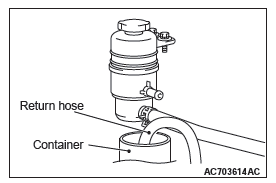
3. Disconnect the all of the injector connectors.
4. While operating the starter motor intermittently, turn the steering wheel all the way to the left and right several times to drain all of the fluid.
5. Connect the return hose securely, and then secure with the clip.
6. Fill the oil reservoir with GENUINE MITSUBISHI POWER STEERING FLUID or ATF DEXRON III/DEXRON II up to the lower position of the filler, and then bleed the air.
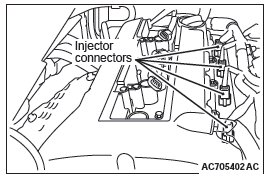
<3.0L ENGINE>
1. Raise and support the front wheels.
2. Disconnect the return hose connection, and then connect a vinyl hose to the return hose, and drain the fluid into a container.
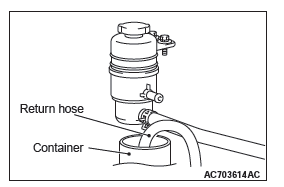
3. Disconnect the camshaft position sensor connector.
4. While operating the starter motor intermittently, turn the steering wheel all the way to the left and right several times to drain all of the fluid.
5. Connect the return hose securely, and then secure with the clip.
6. Fill the oil reservoir with GENUINE MITSUBISHI POWER STEERING FLUID or ATF DEXRON III/DEXRON II up to the lower position of the filler, and then bleed the air.
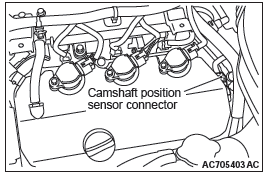
POWER STEERING SYSTEM AIR BLEEDING
Perform air bleeding procedure as necessary after replacing the steering gear or the steering fluid lines.
<2.4L ENGINE>
Required Special Tools:
- MB991958: M.U.T.-III Sub Assembly
1. Raise and support the front wheels.
2. Disconnect the all of the injector connectors.
CAUTION Perform air bleeding only while cranking the engine. If air bleeding is performed while the engine is running, air could enter the fluid. During air bleeding, refill the steering fluid supply so that the level never falls below the lower mark on the dipstick.
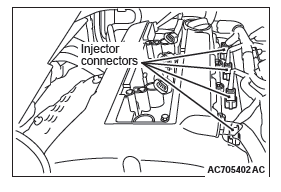
3. Turn the steering wheel all the way to the left and right five or six times while using the starter motor to crank the engine intermittently several times (for 15 to 20 seconds).
4. Connect the all of the injector connectors.
5. Start the engine (idling).
6. Turn the steering wheel to the left and right until there are no air bubbles in the oil reservoir.
7. Confirm that the fluid is not milky, and that the level is between the high and low dipstick marks.
8. Confirm that there is very little change in the fluid level when the steering wheel is turned left and right.
CAUTION If the fluid level rises suddenly after the engine is stopped, the air has not been completely bled. If air bleeding is not complete, there will be abnormal noises from the pump and the flow-control valve, and this condition could cause reduce the life of the power steering components.
9. Confirm that the change in the fluid level is no more than 5 mm (0.2 inch) when the engine is stopped and when it is running.
10.If the change of the fluid level is 5 mm (0.2 inch) or more, the air has not been completely bled from the system. The air bleeding procedure must be repeated.
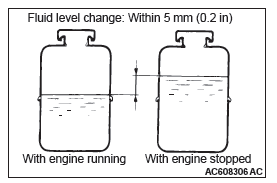
11.Use scan tool to check if the diagnostic trouble code is set. If the diagnostic trouble code is set, erase it.
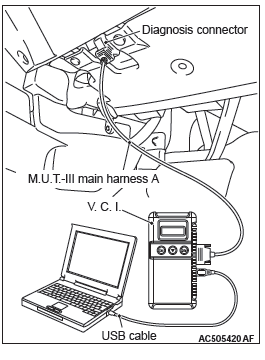
<3.0L ENGINE>
Required Special Tools:
- MB991958: M.U.T.-III Sub Assembly
1. Raise and support the front wheels.
2. Disconnect the camshaft position sensor connector.
CAUTION Perform air bleeding only while cranking the engine. If air bleeding is performed while the engine is running, air could enter the fluid. During air bleeding, refill the steering fluid supply so that the level never falls below the lower mark on the dipstick.
3. Turn the steering wheel all the way to the left and right five or six times while using the starter motor to crank the engine intermittently several times (for 15 to 20 seconds).
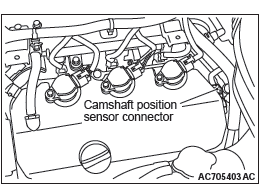
4. Connect the all of the injector connectors.
5. Start the engine (idling).
6. Turn the steering wheel to the left and right until there are no air bubbles in the oil reservoir.
7. Confirm that the fluid is not milky, and that the level is between the high and low dipstick marks.
8. Confirm that there is very little change in the fluid level when the steering wheel is turned left and right.
CAUTION If the fluid level rises suddenly after the engine is stopped, the air has not been completely bled. If air bleeding is not complete, there will be abnormal noises from the pump and the flow-control valve, and this condition could cause reduce the life of the power steering components.
9. Confirm that the change in the fluid level is no more than 5 mm (0.2 inch) when the engine is stopped and when it is running.
10.If the change of the fluid level is 5 mm (0.2 inch) or more, the air has not been completely bled from the system. The air bleeding procedure must be repeated.
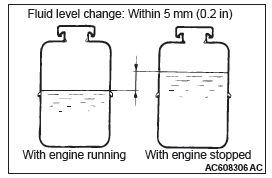
11.Use scan tool to check if the diagnostic trouble code is set. If the diagnostic trouble code is set, erase it.
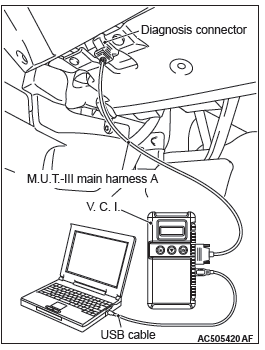
OIL PUMP PRESSURE TEST
Required Special Tools:
- MB990662: Power Steering Oil Pressure Gauge
- MB991548: Oil Pressure Gauge Adapter A (Pump Side)
- MB991549: Oil Pressure Gauge Adapter B (Hose Side)
1. Disconnect the pressure hose from the oil pump, and then connect special tools MB991548, MB990662 and MB991549.
2. Bleed air, then turn the steering wheel several times while the vehicle is not moving so that the temperature of the fluid rises to approximately 50 − 60ºC (122 − 140ºF).
3. Start the engine and idle it at 650 +- 100 r/min <2.4L>, 600 +- 100 r/min <3.0L>.
CAUTION The pressure gauge shut-off valve must not remain closed for more than 10 seconds.
4. Fully close the shut-off valve of the pressure gauge and measure the oil pump relief pressure to confirm that it is within the standard value range. Open it again immediately after checking the pressure.
Standard value: 8.8 − 9.5 MPa (1,276 − 1,378 psi)
5. If it is not within the standard value, replace the oil pump.
6. Check whether or not the hydraulic pressure is the standard value when no-load conditions are created by fully opening the shut-off valve of the pressure gauge.
Standard value: 0.2 − 0.7 MPa (29 − 102 psi)
7. If it is not within the standard value, the probable cause is a malfunction of the oil line or steering gear, so check these parts and repair as necessary.
8. Turn the steering wheel all the way to the left or right; then check whether or not the retention hydraulic pressure is the standard value.
Standard value: 8.8 − 9.5 MPa (1,276 − 1,378 psi)
9. If not the standard value, overhaul the steering gear.
Remeasure fluid pressure.
10. Remove the special tools power steering oil pressure gauge adapter MB991548, MB990662 and MB991549, and then tighten the pressure hose to the specified torque.
Tightening torque: 57 +- 7 N*m (42 +- 5 ft-lb)
11. Bleed the system.
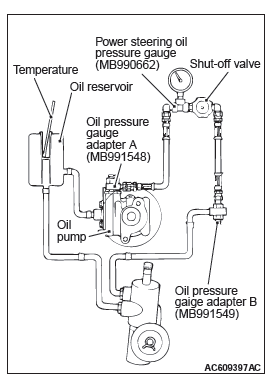
POWER STEERING PRESSURE SWITCH CHECK
Required Special Tools:
- Oil pressure gauge adapter A (pump side) (MB991548)
- Oil pressure gauge adapter B (hose side) (MB991549)
- Power steering oil pressure gauge (MB990662)
1. Disconnect the pressure hose from the oil pump, and then connect special tools MB991548, MB990662 and MB991549.
2. Bleed air, and then turn the steering wheel several times while the vehicle is not moving so that the temperature of the fluid rises to approximately 50 − 60ºC (122 − 140ºF).
3. The engine should be idling.
4. Disconnect the connector for the oil pressure switch, and place an ohmmeter at the switch.
5. Gradually close the shut-off valve of the pressure gauge and increase the hydraulic pressure, then check whether or not the hydraulic pressure that activates the switch is the standard value.
Standard value: 1.5 − 2.0 MPa (218 − 290 psi)
6. Gradually open the shut-off valve and reduce the hydraulic pressure; then check whether or not the hydraulic pressure that deactivates the switch is the standard value.
Standard value: 0.5 − 2.0 MPa (73 − 290 psi)
7. Remove the special tools, and then tighten the pressure hose to the specified torque.
Tightening torque: 57 +- 7 N*m (42 +- 5 ft-lb)
8. Bleed the system.

INSPECTION OF STEERING COLUMN SHAFT ASSEMBLY IMPACT ABSORBING MECHANISM
If a collision accident occurs or severe impact is applied on the steering wheel, the collision energy absorbing mechanism may have operated. Once the mechanism has operated, it will be inoperative even it has suffered no apparent damage. Determine if the steering column shaft can be reused by the following procedure. If the collision energy absorbing mechanism has already operated, replace the steering column shaft assembly.
If any excessive radial free play on the steering wheel is found with the tilt lever in the lock position, always replace the steering shaft assembly.
WARNING
- If the vehicle continues to be driven after the collision absorbing mechanism has operated, the steering column shaft may be damaged while it is in use.
- If there is a slack in the one-way capsule, do not attempt to repair it but replace the steering column shaft assembly.
INSPECTION PROCEDURE
1. Remove the ignition key cover, steering column lower cover, steering column upper cover, WCM, bottom cover assembly (driver's seat), side air outlet (L) and side lower panel assembly.
CAUTION After inspection, do not release the tilt lever until the steering shaft assembly has been installed.
2. Ensure that the tilt lever is in the lock position.
3. Loosen the two upper steering column mounting bolts by two turns.
4. Hold the one-way capsules as shown in the figure, and then try to rock them. If there is a slack in either of the capsules, replace the steering column shaft assembly.
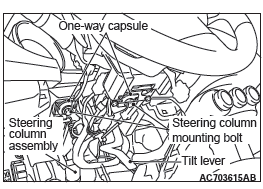
CAUTION
- Be careful that nothing is pinched between the one-way capsules and the body.
- When the replacement, removal, or installation of the steering column shaft assembly is performed, tighten the mounting bolt of the one-way capsule side to the specified torque first.
5. If no malfunction has been found after the inspection, hand-tighten the steering column mounting bolts, and then tighten them to the specified torque.
Tightening torque: 12 +- 3 N*m (106 +- 26 in-lb)
